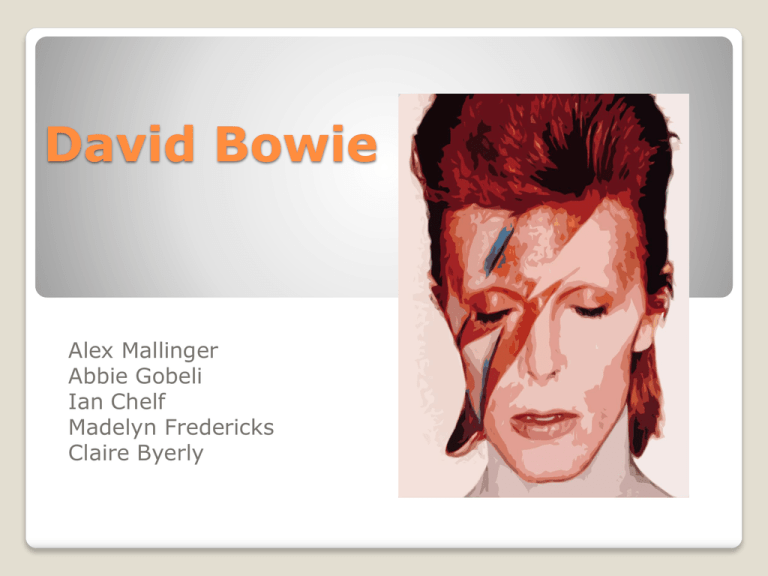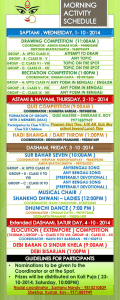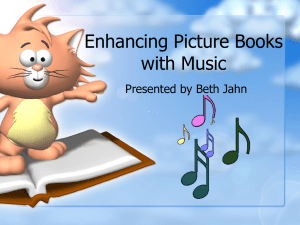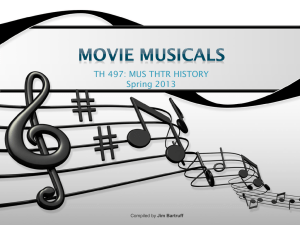
David Bowie
Alex Mallinger
Abbie Gobeli
Ian Chelf
Madelyn Fredericks
Claire Byerly
Introduction
David Bowie has been creating musical works since
the 60s. He has written some of rock and roll's
greatest hits and will forever be known as one of
the great composers of his time. Bowie was a
trendsetter, a rule breaker, and a true artist. He
will always be a major influence to many other
great artists, and his works shall remain timeless.
David Bowie was chosen for our project because
of his great talent and influence on the world of
music.
Biography
David Bowie was born David Robert Jones in
Brixton, London, England on January 8th, 1947
He Graduated from Bromley Technical High School
at age 16
Lead a musical Group "Davy Jones and the Lower
Third"
The group released singles, but not with the
popularity Bowie had
hoped for (David Bowie Biography, 2012)
Biography
David Bowie decided to change his last name to
Bowie out of fear for being mistaken for Davy
Jones of the Monkees. The name was inspired by
the Bowie knife. (David Bowie Biography, 2012)
Bowie decided to venture out on his own, but his
first solo album was unsuccessful so he decided to
take some time away from music.
In 1967 he lived in a buddhist monastery in
Scotland, and started a mime troupe in 1968.
(David Bowie Biography, 2012)
But by 1969, Bowie was back in the music scene.
He signed with Mercury Records and recorded the
single "Space Oddity." The song was released in
1972 in the U.S. and was number 15 on the
charts. (David Bowie Biography, 2012)
Biography
He released the album The Rise and Fall of Ziggy Stardust and the Spiders From Mars in 1972, first
in the UK, then in The U.S. months later and quickly became a superstar. (The Ziggy Stardust
Companion, 2012)
He dressed in wild costumes and portrayed the character of the
unfortunate rockstar "Ziggy Stardust."
Bowie quickly dropped the Ziggy Stardust act and
began to produce albums for Lou Reed and Iggy
Pop. (David Bowie Biography, 2012)
In 1973 he disbanded the Spiders from Mars and
announced he was finished doing live shows.
\
Biography
After dropping the Ziggy Stardust act,
He released David Live in 1974
and Young Americans in 1975.
The album Young Americans
included the song "Fame."
John Lennon was credited as a co-writer in the song
"Fame" because Bowie felt that Lennon gave him the
inspiration through conversations on the subject of
fame.(ASCAP Songwriters #1s Throughout The Years,
2012)
Biography
In 1983, David Bowie signed a new contract with RCA and recorded the album Let's
Dance which included "Modern Love,” "China Girl," and features guitar work by Stevie
Ray Vaughan. (David Bowie Biography, 2012)
Bowie has also starred in many films such as The Man Who Fell To Earth, The
Elephant Man, and Labyrinth.
Bowie is still composing music and even helped Scarlett Johansson compose a Tom
Waits cover album. (David Bowie Biography, 2012)
David Bowie received the Grammy Lifetime achievement award in 2006. (David Bowie
Biography, 2012)
Musical Style
• Bowie was highly interested is
show business and theatre
• He was heavily influenced by
British musical singersongwriter and actor, Anthony
Newley (David Bowie, 2012)
• Adopted his vocal style which
was most noted on David
Bowie
• Theatrics became important
in stage performance
Musical Style
•
•
David Bowie played a
significant amount of
instruments which gave him
an extraordinary talent both
technically and vocally
He has recorded a number of
songs that fit into a variety of
musical styles. Bowie has
been referred to as the leader
of glitter rock in the 1970's,
and at certain points in his
career he tried being a folk
singer, a pop artist, and
participated in various rock
bands.
Instruments Include:
• Guitar
• Saxophone
• Alto
• Piano
• Mellotron
• Harmonica
• Drums & percussion
• Viola & Cello
• Xylophone
Musical Style Character:
Ziggy Stardust
•
The Rise and Fall of
Ziggy Stardust and the
Spiders from Mars
introduced Ziggy
Stardust (Murray, 2012)
•
Was his flamboyant,
androgynous alter ego
•
Re-emerged as this
character in 1972
•
Wore striking costumes
and died his hair red
Musical Style Character:
Thin White Duke
•
Fictional character that went
with the album, Station to
Station
•
Extension of Thomas
Jerome Newton, whom he
portrayed in a film
•
Wardrobe included white
shirt, black pants and vest,
combed back hair
•
Distant and cold charisma
Key Musical Style
Octave switches in different
repetitions of the same
melody
Pitch singing to particular
effects
Dramatic voice changes from
section to section (David
Bowie Biography, 2012)
Musical Style:
Importance in Rock and Roll
Pioneer of glam rock
Thome Forget stated “It is almost
impossible to find a popular artist
today that has not been influenced by
David Bowie” (Jepai, 2012)
Challenged core belief of what rock
music was
Bowie’s record company produced a
slogan for him
Brought new dimension to popular
Musicologist James Perone credits
Bowie as “having brought
sophistication to rock music” (Jepai,
2012)
◦
“There is old wave, there is new
wave, and there is Bowie”
Who Influenced David Bowie?
His first introduction to
instrumentation was learning
the saxaphone at age 13
(David Bowie, 2012)
Marc Bolan and T. Rex
Bolan introduced Bowie to
glam-rock, a genre on the
rise in the late 1960s and
early 1970s
Bowie performed mime at
Bolan's concerts and Bolan
played guitar with him on
songs "The Prettiest Star"
and "Karma Man" (David
•
•
Bowie, 2012)
Marc Bolan
Who Influenced David Bowie?
Bowie's lyrics and music had
specific methods or history
"All the Madmen,"
inspired by Bowie's
institutionalized brother,
Terry. (David Bowie, 2012)
•
•
William Burrough's "cut-up
technique”
Cut up pages of
words, maybe from a
newspaper, then you mix
the words up then put
them together to see
what word patterns you
have
David Bowie
Collaborative Influences
David Bowie was influenced by
artists he initially influenced and
those he collaborated with like
Brian Eno
Bowie's work with Eno included
songs such as:
"Low" (Number 11, 1977),
"Heroes" (Number 35, 1977)
Lodger (Number 20, 1979)
These songs were known for
their unique make-up including
avant-garde electronic music
and the "cut-up" technique
(David Bowie, 2012)
•
Brian Eno
Musically Influenced: Madonna
"Before I saw David Bowie live, I was just your normal, dysfunctional, rebellious teenager
from the Midwest, and he has truly changed my life." -Madonna
(Rock 'N Roll Hall of Fame, 2010)
•influenced Madonna's push
for experimentation in lyrics,
music, and performance
especially related to themes
like sexuality
Musical Contemporaries
From Elvis, who brought a sex-packed set of swaying hips,
to the Beatles who brought the craze, to the Led that who
brought the metal, all of it set the stage for Bowie's
outrageously brilliant four-decade long musical
contributions
Rock and Roll was in a stage of evolution, as it seemed
every up and coming artist was seeking to break into a
new frontier, Bowie was something else
Contemporaries:
◦
The Who
◦
Led Zeppelin
◦
Bob Dylan
◦
Velvet Underground
◦
Elvis Presley
◦
Stevie Ray Vaughn
◦
Iggy Pop
◦
Jimi Hendrix
◦
Janice Joplin
Musical/Historical Contemporaries
Cont.
Iggy Pop & The Stooges - out there and over the top, "No
one liked Iggy and the Stooges unless you were
crossdressing or on some sort of drugs, or had dropped
out of high school or life" - Iggy Pop, Direct influence on
the character of Ziggy Stardust, contributed to his
persona, wanted to emulate
(David Bowie: Sound and Vision Documentary)
Lou Reed & The Velvet Underground - pulled no punches
about lyrical exploration, talked drugs, crossdressing,
unconventional sex, social unrest, had a heavy influence
on Bowie's own songwriting (David Bowie: Sound and
Vision Documentary)
Andy Warhol - Bowie was fascinated by the artist's
approach, Artist's Consortium, fascinated by his AvantGarde and revolutionary approach to Art
The Formation of Ziggy Stardust
"Ziggy really set the pattern for my future work. Ziggy was my Martian messiah who
twanged a guitar. He was a simplistic character. Someone who was dropped down
here, got brought down to our way of thinking and ended up destroying himself." Bowie (The Ziggy Stardust Companion)
Ziggy
- Meant to be the 'ultimate pop icon,' mix of the sound of Lou Reed and the enigmatic
presence of Iggy Pop
- Also built on the name of a Tailor's Shop he saw riding a train one day (Ziggy's) as
well as the British Model Twiggy with whom he appeared on the cover of Pinups with
Stardust
- Comes from Norman Carl Odom's stage name of "The legendary stardust cowboy" was on the Mercury Label with Bowie in 1969
Ziggy Stardust
- Also pulled heavily from the wild and crazy Vince Taylor
- Came from Bowie's desire to write a theatrical, musical piece of work
Historical Background
-
Bowie's musical contributions have spanned four
decades, but central to the development of his early popular
music was the backdrop of the sixties and seventies
- Vietnam War: loss of young American lives for a
seemingly pointless and endless War
- Development of East - West, Capitalistic - Communist,
tensions across the globe
- Commitment to country vs. Disillusionment of the same
country firing on its own citizens (Kent State Shootings)
- Freedom of thought, love, and expression meets the
reality of a rapidly developing capitalistic nation
- Every time period is rich in material, but perhaps what is
notable is the rapidity of the changing American identity
which heavily influenced Bowie artistic endeavors
Historical Background Cont.
Perhaps the most interesting of historical
influences was intentional release of 'Space Oddity'
to coincide with the first moon landing (Telegraph,
Moon Music 2011)
Landing on the moon represented one of man's
greatest achievements, and now a future full of
limitless possibilities provided a great lyrical base
This was contrasted by a fear of man's potential,
and his role in space
Use of Major Tom as a fictional character caught off
guard by the loneliness of a silent space (Telegraph,
Moon Music 2011)
Space Race as a fuel for developing East-West
tensions around the world
Major Tom was written by Bowie after seeing Stanley
Kubrick's 2001: A Space Odyessy while "stoned out of
his mind." (David Bowie Biography 2012)
Trent Reznor (Nine Inch Nails)
"One of my biggest heroes and
people I was fortunate enough to
be around is David Bowie. I look
at his career, and he always had
the balls to break things that
weren’t broken, to step away from
something and try something new,
at risk of failing." -Trent Reznor
(Ryan,2009)
David Bowie's vast experience in
dabbling in numerous musical
genres allowed for Reznor to
experiment within the wide rock
spectrum including Industrial.
Bowie's changes in vocals helped
pave the way for Trent to
experiment with dynamics ranging
from songs that turn from
whispers to screams
Musical Analysis- "Space Oddity"
Song Background
Our group agreed that before analyzing
the musical elements of this song, that
it would be beneficial to provide a bit
of background of the single "Space
Oddity" as well. As mentioned in his
biography earlier in the presentation, it
was recorded in 1969. Once released
in 1972 it was a hit in both the U.K.
and America. The song appears on the
album David Bowie. Space Oddity was
released at the time of the moon
landing, and was used by the BBC in
their coverage of the event making it
famous. This was despite the fact
that, in reality, the lyrics had to do
with an astronaut lost in space. Here
is a link to the song: (David Bowie
Biography, 2012)
http://www.youtube.com/watch?v=uhSYb
RiYwTY
Musical Analysis- "Space Oddity"
Instrumentation
We noticed an integration of vocals, both
electric and acoustic guitar, drums,
handclapping, violin, and bass.
However most notably is the use of an
instrument innovative of its time and
one that many may not recognize. We
are referring to the use of the
Stylophone.
"The Stylophone's an odd duck of an instrument.
Long before the iPhone's numerous instrument
apps came along, Brian Jarvis created this
pocket-sized synthesizer in 1967. The Stylophone
player makes music be touching a pen-shaped
stylus to the small keyboard, a voltage-controlled
oscillator sounding a note each time. Countless
musical instruments are invented each year and
almost all remain in obscurity. But this strange
and not-particularly-pleasant-sounding device
found its way onto an international hit within two
years, when Bowie recorded "Space Oddity"."
(Weir, 2011)
Here is a link to a video that
demonstrates the use of the
stylophone. After watching this, it is
easier to find its existence throughout
the song.
http://www.youtube.com/watch?v=cFXLAqaFj2Q&fea
ture=topics
Musical Analysis- "Space Oddity"
Meter and Beat subdivision,
The song begins with a quadruple meter
format, and the drum rolling provides a
complex beat subdivision. After the
spoken countdown (roughly 1:20 into
the video), quadruple meter remains
and the drums accent beats 2 and 4
giving the song a strong backbeat and
there's a duple beat subdivision. At the
2:05 mark the song transitions into
another complex beat subdivision. At
2:25 when we hear only Bowie's guitar,
the offbeat of beat three and beat four
are accompanied with claps for
emphasis. This only lasts for two
measures, however, before moving into
another beat subdivision that is
complicated and hard to identify. The
remainder of the song is a trade-off
between these variations.
Musical Analysis- "Space Oddity"
Texture
The song begins with a tradeoff between
an acoustic guitar and the stylophone
for a monophonic beginning. Vocals
soon come in to support a new guitar
rhythm for a homophonic melody and
accompainment texture. After the
spoken countdown, polyphonic
nonimitative texture makes its way in
as the majority of the instruments that
exist throughout the song feed off each
other. Eventually guitar is on its own
with the exception of occasional claps
creating a brief two measures of
monophonic texture. "Space Oddity"
consists of a tradeoff between these
textures.
Musical Analysis- "Space Oddity"
Form
1. Ground control to major Tom
Ground control to major Tom
Take your protein pills and put your helmet on
(Ten) Ground control (Nine) to major Tom (Eight)
(Seven, six) Commencing countdown (Five), engines on (Four)
(Three, two) Check ignition (One) and may gods (Blastoff) love be with you
2. This is ground control to major Tom, you've really made the grade
And the papers want to know whose shirts you wear
Now it's time to leave the capsule if you dare
[ Lyrics from: http://www.lyricsfreak.com/d/david+bowie/space+oddity_20036711.html ]
3. This is major Tom to ground control, I'm stepping through the door
The lyrics to the left are difficult to read but having
them there should make it easier for one to
understand where we are referencing when we
label micro and macrostructure forms.
Microstructure
Verse one: AAB, AAB,
Verse two: ABB,
Verse three: ABB, ABC
Instrumentals
Verse four: ABB, ABB, ABC, ABC
And I'm floating in a most peculiar way
And the stars look very different today
Here am I sitting in a tin can far above the world
Planet Earth is blue and there's nothing I can do
4. Though I'm past one hundred thousand miles, I'm feeling very still
And I think my spaceship knows which way to go
Tell my wife I love her very much, she knows
Ground control to major Tom, your circuits dead, there's something wrong
Can you hear me, major Tom?
Can you hear me, major Tom?
Can you hear me, major Tom?
Can you...
Here am I sitting in my tin can far above the Moon
Planet Earth is blue and there's nothing I can do4.
Macrostructure
If we're use the lyrics on the left as our template for
dividing verses, then due to the fact that all are
different from each other in some way, the form
for the overall song is ABCD.
Conclusion
David Bowie's unique talent made him an icon in popular
music. He was fearless in his approach to music, art, fashion,sex,
and all things rock and roll. He revolutionized the genre by pushing
the boundaries, battled social prejudice, personal tragedy, and like
many artists, a drug problem, but in the process he produced a
sound that is distinctly his own. The key to his success? A neverending desire for change, on the most epic of scales. His influence
has spanned decades, and is still being felt across genres today.
References
ASCAP Songwriters #1s Throughout The Years. (2012, June 26). Retrieved from LimeLight:
http://www.songclearance.com/blog/ascap-artists-1s-throughout-the-years-%E2%80%93-92075
IMDb.
David bowie. (2012). Rolling Stone, Retrieved from http://www.rollingstone.com/music/artists/davidbowie/biography
David Bowie Biography. (2012, June 26). Retrieved from www.biography.com:
http://www.biography.com/people/david-bowie-9222045
The Ziggy Stardust Companion. (2012, June 26). Retrieved from www.5years.com:
http://www.5years.com/release.htm
Jepai. (2012, June 7). David bowie. Retrieved from http://community.rock.com/profiles/blogs/david-bowie
LiveWire Staff. (n.d.). The top ten most influential rock artists of all-time . Retrieved from
http://www.concertlivewire.com/top10in.htm
Lipscomb, Scott. (
Murray, C. (2012, June 12). The guardian. Retrieved from http://www.guardian.co.uk/music/2012/jun/12/davidbowie-ziggy-stardust-interview
Rock 'N Roll Hall of Fame. (2010). Madonna accepts for david bowie. Retrieved from
http://rockhall.com/inductees/david-bowie/transcript/madonna-accepts-for-david-bowi/
Ryan, K. (2009). Trent reznor of nine inch nails. The A.V. Club, Retrieved from
http://www.avclub.com/articles/trent-reznor-of-nine-inch-nails,32806/
Youtube. (2006, March 11). David Bowie's """"Space Oddity. Retrieved from
http://www.youtube.com/watch?v=uhSYbRiYwTY
Youtube. (2010, MArch 17). DUBREQ STYLOPHONE Original 1968 - played with effects | HQ DEMO. Retrieved
from http://www.youtube.com/watch?v=cFXLAqaFj2Q&feature=topics
Weir, William.. (2009, July 11). The Stylophone, the Mellotron and the Odd 1960s Technology of "Space Oddity".
Retrieved from http://blogs.courant.com/bill_weir/2009/07/-and-heres-more-about.html
References Cont.
Top Documentary Films, (2003). David Bowie: Sound and Music. Retrieved from
http://topdocumentaryfilms.com/david-bowie-sound-and-vision/
Kosoff, Julian. (Jul, 20. 2012) Apollo 11 Moon Landing: Moon Music. Telegraph
Website. Retrieved from
http://www.telegraph.co.uk/science/space/5871370/Apollo-11-moon-landing-Moon-music.html









